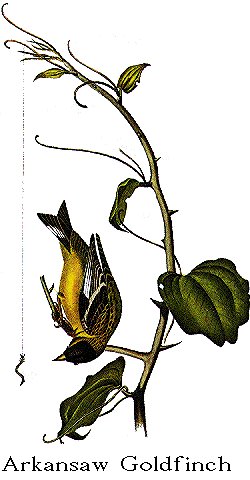
| Family XV. FRINGILLINAE. FINCHES. GENUS VIII. CARDUELIS, Cuv. GOLDFINCH. |
Next >> |

Family |
ARKANSAW GOLDFINCH. [Lesser Goldfinch (see also Yarrell's Goldfinch).] |
| Genus | CARDUELIS PSALTRIA, Say. [Carduelis psaltria.] |
This pretty little species first added to our Fauna by THOMAS SAY, who
procured it in the course of Colonel LONG's expedition to the Rocky Mountains,
visits the lower parts of Louisiana at irregular periods, although always during
winter. I have procured individuals a few miles from Bayou Sara. They fly
loosely together, alight after performing some evolutions, made as if to
ascertain the absence of danger, and, as soon as they are on the trees or on the
ground, proceed to search for food. The only notes I heard them utter, somewhat
resembled those of C. tristis, the American Goldfinch. They are impatient
birds, and seldom remain long in the same spot, but change to and fro in the
same locality. No individuals of this species were observed by NUTTALL or
TOWNSEND in the course of their journey to and across the Rocky Mountains. My
figure is that of an old male drawn at Bayou Sara.
Eastern bases of Rocky Mountains, and Western Plains. Accidental in Lower
Louisiana. Common. Migratory.
ARKANSAW SISKIN, Fringilla psaltria, Say, Long's Exped., vol. ii. p. 40.
FRINGILLA PSALTRIA, Bonap. Syn., p. 111.
ARKANSAS SISKIN, Nutt. Man., vol. i. p. 510.
ARKANSAW SISKIN, Fringilla psaltria, Aud. Orn. Biog., vol. v. p. 85.
Adult Male.
Bill short, conical, stout, compressed toward the end, the tip acute; upper
mandible with the dorsal line somewhat convex, the ridge indistinct, the sides
rounded, the edges sharp, declinate at the base, the tip narrow; lower mandible
with the angle very short and semicircular, the dorsal line straight, the sides
convex, the edges inflected, the tip acute. Nostrils basal, round, concealed by
the feathers.
Head rather large, broadly ovate; neck short; body moderate. Feet of
moderate size; tarsus rather short, compressed, with seven anterior scutella,
and two plates behind meeting so as to form a very sharp edge; toes rather
large, the lateral equal, the first stouter; claws rather long, moderately
arched, much compressed, laterally grooved, very acute.
Plumage very soft and blended; short stiffish feathers at the base of the
bill. Wings rather long, little concave; the second, third, and fourth
primaries cut out toward the end; the second longest, the first half a twelfth
shorter, the third scarcely a quarter of a twelfth shorter than the second, and
exceeding the fourth by a twelfth and a half, the next four and a quarter
twelfths shorter; some of the inner primaries and most of the secondaries
distinctly emarginate. Tail rather short, deeply emarginate, the feathers
obliquely pointed and divaricate.
Bill flesh-coloured, the upper mandible dusky toward the end. Feet and
claws reddish-brown. The upper part of the head is deep black; the hind neck,
back, and scapulars yellowish-green, each feather greenish-brown in the centre;
the rump greenish-yellow, the upper tail coverts dusky, margined with
greenish-yellow, as are the smaller wing-coverts. The other coverts and quills
are black; the secondary-coverts broadly tipped with pale yellow, which forms a
conspicuous band across the wing; the quills are margined with yellowish-white,
the inner more broadly; all the quills, the outer three, and the inner
secondaries excepted, are white toward the base, The tail is brownish-black, the
feathers narrowly edged with brownish-white, and all, excepting the two middle
and the lateral, with a white space at the base, which runs out along the outer
margin forming a conspicuous patch. All the lower parts are bright-yellow, but
the cheeks and the sides of the neck are tinged with green, and the feathers of
the chin are blackish in the centre.
Length to end of tail 4 1/2 inches; extent of wings 8; bill along the ridge
(4 1/2)/12 along the edge of lower mandible (5 3/4)/12; wing from flexure
2 1/12; tail 2; tarsus 7/12; hind toe 4/12, its claw (3 1/2)/12; middle toe
(6 1/4)/12, its claw 3/12.
The female is similar to the male, but wants the black patch on the head,
that part being green like the back.
| Next >> |